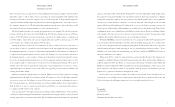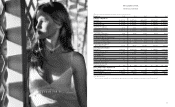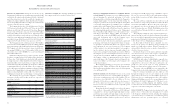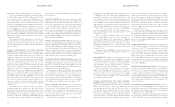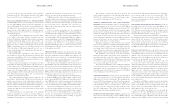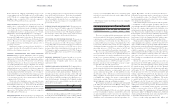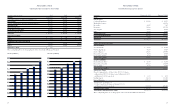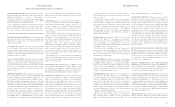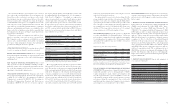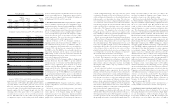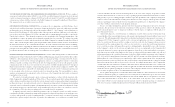Abercrombie & Fitch 2004 Annual Report Download - page 13
Download and view the complete annual report
Please find page 13 of the 2004 Abercrombie & Fitch annual report below. You can navigate through the pages in the report by either clicking on the pages listed below, or by using the keyword search tool below to find specific information within the annual report.
■availability and market prices of key raw materials;
■currency and exchange risks and changes in existing or potential
duties, tariffs or quotas;
■availability of suitable store locations on appropriate terms;
■ability to develop new merchandise;
■ability to hire, train and retain associates; and
■the effects of political and economic events and conditions
domestically and in foreign jurisdictions in which the Company
operates, including, but not limited to, acts of terrorism or war.
Future economic and industry trends that could potentially
impact revenue and profitability are difficult to predict. Therefore,
there can be no assurance that the forward-looking statements
included in this report will prove to be accurate and the inclusion
of such information should not be regarded as a representation by
the Company, or any other person, that its objectives will be
achieved. Except as may be required by applicable law, the
Company assumes no obligation to publicly update or revise its
forward-looking statements.
Because forward-looking statements involve risks and uncer-
tainties, the Company cautions that there are important factors, in
addition to those listed above, that may cause actual results to differ
materially from those contained in the forward-looking statements.
QUANTITIVE AND QUALITIVE DISCLOSURES ABOUT MAR-
KET RISK The Company maintains its cash equivalents in financial
instruments with original maturities of 90 days or less. The
Company also holds investments in marketable securities, which pri-
marily consist of investment grade auction rate securities classified
as available-for-sale. These securities are consistent with the invest-
ment objectives contained within the investment policy established
by the Company’s Board of Directors. The basic objectives are the
preservation of capital, maintaining sufficient liquidity to meet
operating requirements and maximizing net after-tax yield. Despite
the long-term maturity of auction rate securities, from the investor’s
perspective, such securities are priced and subsequently traded as
short-term investments because of the interest rate reset feature.
Interest rates are reset at predetermined periods ranging from 7 to 49
days. Failed auctions occur rarely. As of January 29, 2005, the Company
held no auction rate securities.
The Company does not enter into financial instruments for
trading purposes.
As of January 29, 2005, the Company had no long-term debt
outstanding. Future borrowings would bear interest at negotiated
rates and would be subject to interest rate risk. The Company does
not believe that an adverse change in interest rates would have a
material affect on the Company’s financial condition.
Abercrombie &Fitch
23
Abercrombie &Fitch
calculation are certain significant judgments and estimates includ-
ing, among others, initial markup, markdowns and shrinkage,
which could significantly impact the ending inventory valuation at
cost as well as the resulting gross margins. Management believes
that this inventory valuation method is appropriate since it pre-
serves the cost-to-retail relationship in ending inventory.
Property and Equipment - Depreciation and amortization of
property and equipment are computed for financial reporting pur-
poses on a straight-line basis, using service lives ranging principally
from 30 years for buildings, the lesser of 10 years or the life of the
lease for leasehold improvements and 3 to 10 years for other proper-
ty and equipment. Beneficial leaseholds represent the present value
of the excess of fair market rent over contractual rent of existing
stores at the 1988 purchase of the Abercrombie & Fitch business by
The Limited, Inc. (now known as Limited Brands, Inc., “The
Limited”) and are being amortized over the lives of the related leas-
es. The cost of assets sold or retired and the related accumulated
depreciation or amortizations are removed from the accounts with
any resulting gain or loss included in net income. Maintenance and
repairs are charged to expense as incurred. Major remodels and
improvements that extend service lives of the assets are capitalized.
Long-lived assets are reviewed at the store level at least annually for
impairment or whenever events or changes in circumstances indi-
cate that full recoverability is questionable. Factors used in the eval-
uation include, but are not limited to, management's plans for future
operations, recent operating results and projected cash flows.
Income Taxes - Income taxes are calculated in accordance with
SFAS No. 109, "Accounting for Income Taxes," which requires the
use of the asset and liability method. Deferred tax assets and lia-
bilities are recognized based on the difference between the financial
statement carrying amounts of existing assets and liabilities and
their respective tax bases. Inherent in the measurement of deferred
balances are certain judgments and interpretations of enacted tax
law and published guidance with respect to applicability to the
Company’s operations. Significant examples of this concept
include capitalization policies for various tangible and intangible
costs, income and expense recognition and inventory valuation
methods. No valuation allowance has been provided for deferred
tax assets because management believes the full amount of the net
deferred tax assets will be realized in the future. The effective tax
rate utilized by the Company reflects management’s judgment of
the expected tax liabilities within the various taxing jurisdictions.
Contingencies - In the normal course of business, the Company
must make continuing estimates of potential future legal obligations
and liabilities, which requires the use of management’s judgment
on the outcome of various issues. Management may also use out-
side legal advice to assist in the estimating process. However, the
ultimate outcome of various legal issues could be different than
management estimates, and adjustments may be required.
RECENTLY ISSUED ACCOUNTING PRONOUNCEMENTS In
December 2004, the Financial Accounting Standards Board ("FASB")
issued Statement No. 123R ("SFAS 123R"), "Share-Based Payment,"
a revision of FASB issued Statement No. 123 ("SFAS 123"),
"Accounting for Stock-Based Compensation." SFAS 123R requires
an entity to recognize compensation expense in an amount equal to
the fair value of share-based payments granted to employees. The
pro forma disclosures previously permitted under SFAS 123 will no
longer be an alternative to financial statement recognition. See Note
2 of the Notes to Consolidated Financial Statements for the pro forma
net income and earnings per share amounts for fiscal 2002 through
fiscal 2004, as if the Company had used a fair-value based method
similar to the methods required under SFAS 123R to measure com-
pensation expense for employee stock-based compensation awards.
The accounting provisions of SFAS 123R are effective for reporting
periods beginning after June 15, 2005. The Company is still in the
process of determining the impact on the results of operations and
financial position upon the adoption of SFAS 123R.
IMPACT OF INFLATION The Company's results of operations
and financial condition are presented based upon historical cost.
While it is difficult to accurately measure the impact of inflation due
to the imprecise nature of the estimates required, the Company
believes that the effects of inflation, if any, on its results of operations
and financial condition have been minor.
FORWARD-LOOKING STATEMENTS AND RISK FACTORS The
Company cautions that any forward-looking statements (as such
term is defined in the Private Securities Litigation Reform Act of
1995) contained in this Form 10-K or made by management involve
risks and uncertainties and are subject to change based on various
important factors, many of which may be beyond its control. Words
such as “estimate,” “project,” “plan,” “believe,” “expect,” “anticipate,”
“intend,” and similar expressions may identify forward-looking
statements. The following factors in some cases have affected and
in the future could affect the Company’s financial performance
and could cause actual results to differ materially from those
expressed or implied in any of the forward-looking statements
included in this report or otherwise made by management:
■changes in consumer spending patterns and consumer prefer-
ences;
■the impact of competition and pricing;
■disruptive weather conditions;
22




